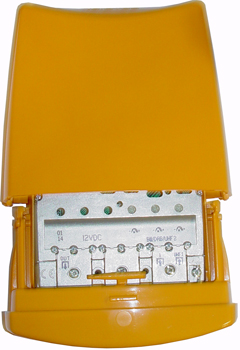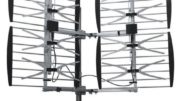There are two different kinds of antenna amplfiers. Preamplifiers are usually used fairly close to the antenna and are used to compensate for long runs between the antenna and the TV. Distribution amplifiers are traditionally used inside (or just outside) of the building to provide extra power to make up for long runs inside the home and the loss created by splitters.
Do you need both?
For a just a few TVs in an average sized house, you probably don’t. You probably will do just fine with one or the other. Which to choose? It depends on your situation. If you are trying to pull in more distant stations, or if the cable from antenna to the inside is long, you’ll want a preamplifier. If you have quite a few TVs in the house or a very large house, you’d want a distribution amplifier.
This Televes amplifier is actually sort of halfway between preamp and distribution amp. It’s designed to be used near the antenna but it’s also designed more like a distribution amplifier, with a little more noise and the ability to combine more than one source. One unique feature is that it will provide power to the preamps located inside Televes antennas, if you want it to. It even has multiple outputs at the power supply. That makes it easy to run multiple TVs. It’s a smart move no matter what.
Just the right amount of amplification
Generally, I don’t favor overamplifying a signal. It can become distorted and actually make for worse reception. If the amplifier and the antenna are close together, that means you probably don’t need the preamp, and that the distribution amp will do everything you need. There’s a little switch on the inside of the Televes amplifier that controls whether or not the antenna gets power or not. If you’re not providing power, the amplifier inside the antenna won’t amplify, but it will still pass signal (at least if it’s a Televes antenna.)
It’s important to understand that when you’re looking at digital signals, more amplification isn’t necessarily better. With a digital signal, the tuner either can read it or it can’t, period. There’s a very, very narrow window where an amplifier will actually help you get distant signals. This is unlike analog signals which fall off a lot more slowly and therefore benefit from amplification. If you’re using an antenna and you add an amplifier to get better signal, it may work but if it doesn’t… adding a stronger amplifier probably isn’t going to work either. Stacking one amplifier on another shouldn’t be necessary unless you have very long cable runs or are using a lot of splitters.
Have more questions?
If you have questions about antenna tech, call the experts! The folks at Solid Signal are real, certified antenna technicians. Best of all, they actually answer the phone. They’re here for you during East Coast business hours. All you have to do is call. The number is 888-233-7563. It’s easy. We don’t have script readers… we have professionals. Give us a try! Call now, or if it’s after hours just fill out the form below. We’ll get back to you, usually within one business day.





